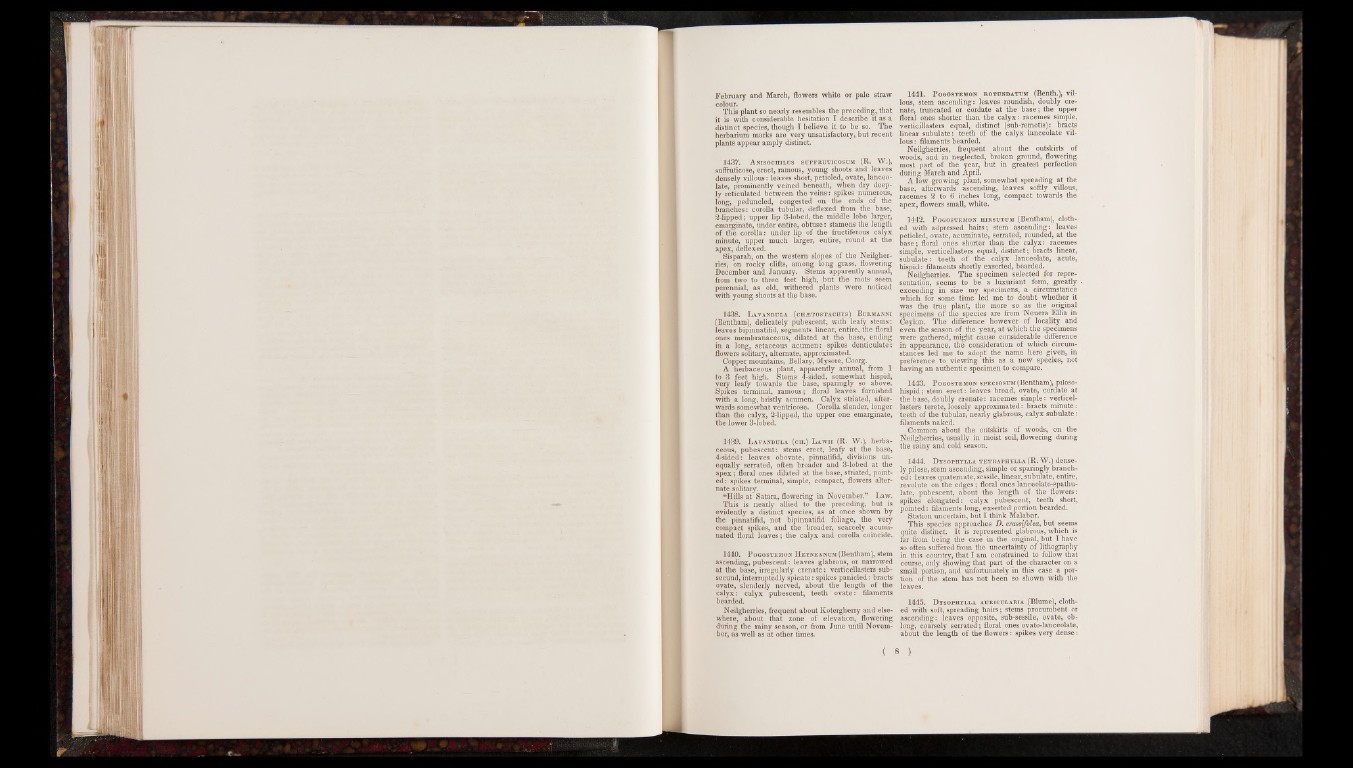
February and March, flowers white or pale straw
colour.
This plant so nearly resembles the preceding, that
it is with considerable hesitation I describe it as a
distinct species, though I believe it to be so. The
herbarium marks are very unsatisfactory, but recent
plants appear amply distinct.
1437. Antsochilus suffruticosum (R. W.),
suffruticose, erect, ramous, young shoots and leaves
densely villous: leaves short, petioled, ovate, lanceolate,
prominently veined beneath, when dry deeply
reticulated between the veins: spikes numerous,
long, peduncled, congested on the ends of the
branches: corolla tubular, deflexed from the base,
2-lipped; upper lip 3-lobed, the middle lobe larger,
emarginate, under entire, obtuse: stamens the length
of the corolla: under lip of the fructiferous calyx
minute, upper much larger, entire, round at the
apex, deflexed.
Sisparah, on the western slopes of the Neilgher-
ries, on rocky clifts, among long grass, flowering
December and January. Stems apparently annual,
from two to three feet high, „but the roots seem
perennial, as old, withered plants were noticed
with young shoots at the base.
1438. Lavandula./(cuetostachys) Burmannx
(Bentham), delicately pubescent, with leafy stems:
leaves bipinnatifid, segments linear, entire, the floral
ones membranaceous, dilated at the base, ending
in a long, setaceous acumen: Spikes denticulate:
flowers solitary, alternate, approximated.
Copper mountains, Bellary, Mysore, Coorg.
A herbaceous plant, apparently annual, from 1
to 3 feet high. Stems 4-sided, somewhat hispid,
very leafy towards the base, sparingly so above.
Spikes terminal, ramous;' floral leaves furnished
with a long, bristly acumen. Calyx striated, afterwards
somewhat ventricose. Corolla slender, longer
than the calyx, 2-lipped, the upper one emarginate,
the lower 3-lobed.
1439. Lavandula (ch.) Lawii (R. W .l herbaceous,
pubescent: stems erect, leafy at the base,
4-sided: leaves obovate, pinnatifid, divisions unequally
serrated, often broader and 3-lobed at the
apex; floral ones dilated at the base, striated, pointed:
spikes terminal, simple, compact, flowers alternate
solitary.
“Hills at Satara, flowering in November.” Law.
This is nearly allied to the preceding, but is
evidently a distinct species, as at once shown by
the pinnatifid, not bipinnatifid foliage, the very
compact spikes, and the broader, scarcely acuminated
floral leaves; the calyx and corolla coincide.
1440. P ogostemon Heyneanum (Bentham), stem
ascending, pubescent: leaves glabrous, or narrowed
at the base, irregularly crenate: verticellasters sub-
secund, interruptedly spicate: spikes panicled: bracts
ovate, slenderly nerved, about the length of the
calyx: calyx pubescent, teeth ovate: filaments
bearded.
Neilgherries, frequent about Kotergherry and elsewhere,
about that zone of elevation, flowering
during the rainy season, or from June until November,
as well as at other times.
1441. Pogostemon rotundatum (Benth.), villous,
stem ascending: leaves roundish, doubly crenate,
truncated or cordate at the base; the upper
floral ones shorter than the calyx: racemes simple,
verticillasters equal, distinct (sub-remotis): bracts
linear subulate: teeth of the calyx lanceolate villous
: filaments bearded.
Neilgherries, frequent about the outskirts of
woods, and in neglected, broken ground, flowering
most part of the year, but in greatest perfection
during March and April.
A low growing plant, somewhat spreading at the
base, afterwards ascending, leaves softly villous,
racemes 2 to 6 inches long, compact towards the
apex, flowers small, white.
1442. Pogostemon hirsutum (Bentham), clothed
with adpressed hairs; stem ascending: leaves
petioled, ovate, acuminate, serrated, rounded, at the
base; floral ones shorter than the calyx: racemes
simple, verticellasters equal, distinct; bracts linear,
subulate: teeth of the calyx lanceolate, acute,
hispid: filaments shortly exserted, bearded.
Neilgherries. The specimen selected for representation,
seems to be a luxuriant form, greatly
exceeding in size my specimens, a circumstance
which for some time led me to doubt whether it
was the true plant, the more so as the original
specimens o f the species are from Neuera Ellia in
Ceylon. The difference however of locality and
even the season of the year, at which the specimens
were gathered, might cause considerable difference
in appearance, the consideration of which circumstances
led me to adopt the name here given, in
preference to viewing this as a new species, not
having an authentic specimen to compare.
1443. P ogostemon speciosum (Bentham), piloso-
hispid; stem erect: leaves broad, ovate, cordate at
the base, doubly crenate: racemes simple: verticellasters
terete, loosely approximated: bracts minute:
teeth of the tubular, nearly glabrous, calyx subulate:
filaments naked.
Common about the outskirts of woods, on the
Neilgherries, usually in moist soil, flowering during
the rainy and cold season.
1444. Dysophylla tetraphylla (R. W .) densely
pilose, stem ascending, simple or sparingly branched
: leaves quaternate, sessile, linear, subulate, entire,
revolute on the edges; floral ones lanceolato-spathu-
late, pubescent, about the length of the flowers:
spikes elongated: calyx pubescent, teeth short,
pointed: filaments long, exserted portion bearded.
Station uncertain, but I think Malabar.
This species approaches D. crassifolea, but seems
quite distinct. It is represented glabrous, which is
far from being the case in the original, but . I have
so often suffered from the uncertainty of lithography
in this country, that I am constrained to follow that
course, only snowing that part of the character on a
small portion, and unfortunately in this case a portion
of the stem has not been so shown with the
leaves.
1445. Dysophylla auricularia (Blume), clothed
with soft, spreading hairs; stems procumbent or
ascending: leaves opposite, sub-sessile, ovate, oblong,
coarsely serrated; floral ones ovato-lanceolate,
about tile length of the flowers: spikes very dense: